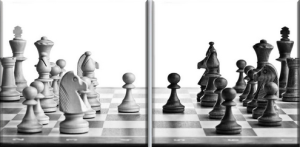Weak pawns belong to the most important topics in chess, as they constitute an interception point of several concepts. As we know from Philidor, pawns are the soul of chess. The pawn structure is the defining element of a position and determines the plans for both parties. Then, we have have the concept of weakness, which is a center piece of chess strategy. Weaknesses have to be avoided, created, provoked and exploited. Beside the king, which is precious and not very mobile, the pawns are the second important kind of weakness through their immobility. This is, where the third concept comes into play: static versus dynamic advantage. The general rule is to aim at turning a volatile dynamic advantage, e.g. initiative into a permanent static advantage, such as weak pawns. The following specific topics are dealt with:
- The IQP – pros and cons
- Further kinds of isolated pawns
- The quasi isolated pawn
- Doubled pawns
- The backward pawn
- Hanging pawns
- Fixed pawns
- Quasi fixed pawns
- The exposed central pawn
- The exposed bishop pawn
- The exposed knight pawn
- The exposed rook pawn
- Multiple weaknesses
- Hidden weaknesses
- Sacrifices for structure
Schedule
A course consists of ten 2 hour sessions. There is one session per week. Every session takes place between 7 pm and 9:05 pm CET (5 minute break).
Events: 10 Jan 17 Jan 24 Jan 31 Jan 7 Feb 14 Feb 21 Feb 28 Feb 7 Mar 14 Mar
Maximum group size
The course will be closed after 12 registrations.
Target group
Up to Elo 2250
Handout
cbv/pgn + session video
Fee
EUR 200 per course (= EUR 10 per hour), payment upfront, children and juveniles 25% discount
Registration
info (at) matthias-wahls (dot) com
